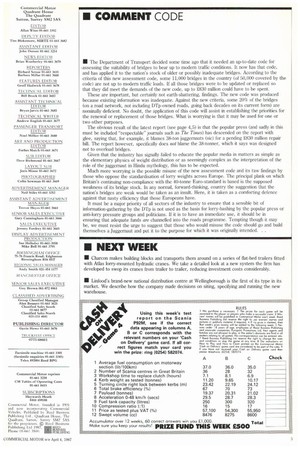• The Department of Transport decided some time ago that
Page 5

If you've noticed an error in this article please click here to report it so we can fix it.
it needed an up-to-date code for -assessing the suitability of bridges to bear up to modern traffic conditions. It now has that code, and has applied it to the nation's stock of older or possibly inadequate bridges. According to the criteria of this new assessment code, some 11,000 bridges in the country (of 50,000 covered by the code) are not up to modern traffic loads. If all those bridges were to be updated or replaced so that they did meet the demands of the new code, up to £830 million could have to be spent.
These are important, but certainly not earth-shattering, findings. The new code was produced because existing information was inadequate. Against the new criteria, some 20% of the bridges (on a road network, not including Dip-owned roads, going back decades on its current form) are nominally deficient. No doubt, the application of this code wilt assist in establishing the priorities for the renewal or replacement of those bridges. What is worrying is that it may be used for one or two other purposes.
The obvious result of the latest report (see page 4,5) is that the popular press (and sadly in this must be included "respectable" journals such as The Times) has descended on the report with glee, saying that, for example, it blames 38-ton juggernauts (sic) for a pending £830 million repair bill. The report however, specifically does not blame the 38-tonner, which it says was designed not to overload bridges.
Given that the industry has signally failed to educate the popular media in matters as simple as the elementary physics of weight distribution or as seemingly complex as the interpretation of the role of the juggernaut in Hindu mythology, this has to be expected.
Much more worrying is the possible misuse of the new assessment code and its Law findings by those who oppose the standardisation of lorry weights across Europe. The principal plank on which Britain's continuing non-compliance with the 40-tonne Euro-standard is based is the supposed weakness of its bridge stock. In any normal, forward-thinking, country the suggestion that the nation's bridges are weak would be taken as an insult. Here, it is taken as a comforting defence against that nasty efficiency that those Europeans have.
It must be a major priority of all sectors of the industry to ensure that a sensible bit of information-gathering by the DTp is not used as the basis for lorry-bashing by the popular press or anti-lorry pressure groups and politicians. If it is to have an immediate use, it should be in ensuring that adequate funds are channelled into the roads programme. Tempting though it may be, we must resist the urge to suggest that those who would misuse the code should go and build themselves a Juggernaut and put it to the purpose for which it was originally intended. . .




















































































